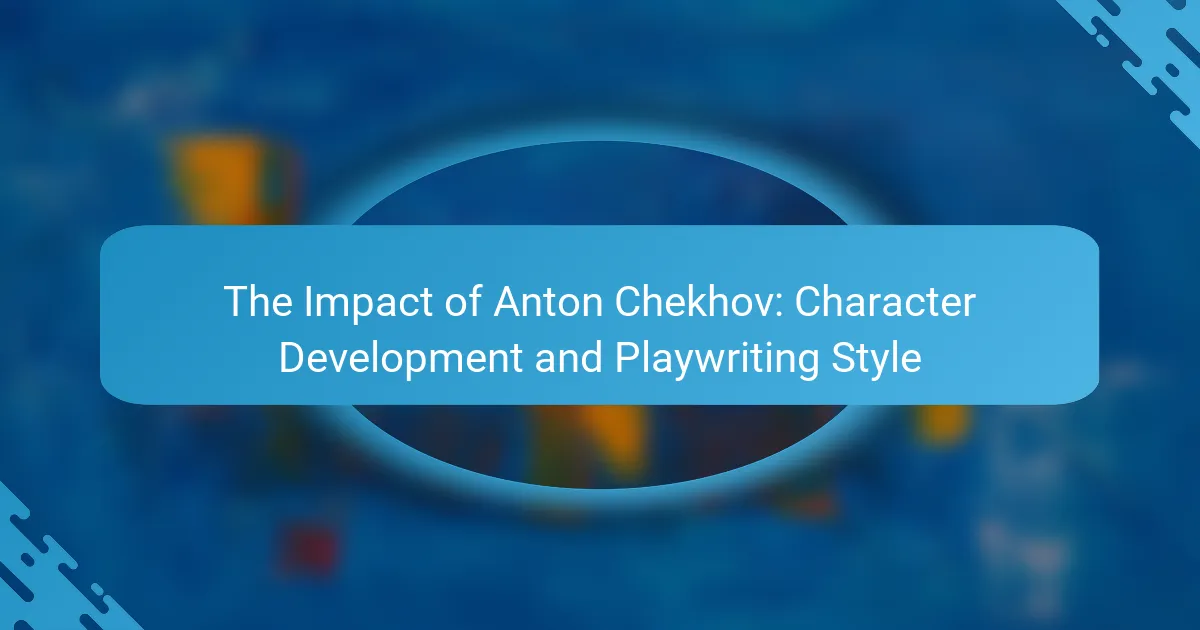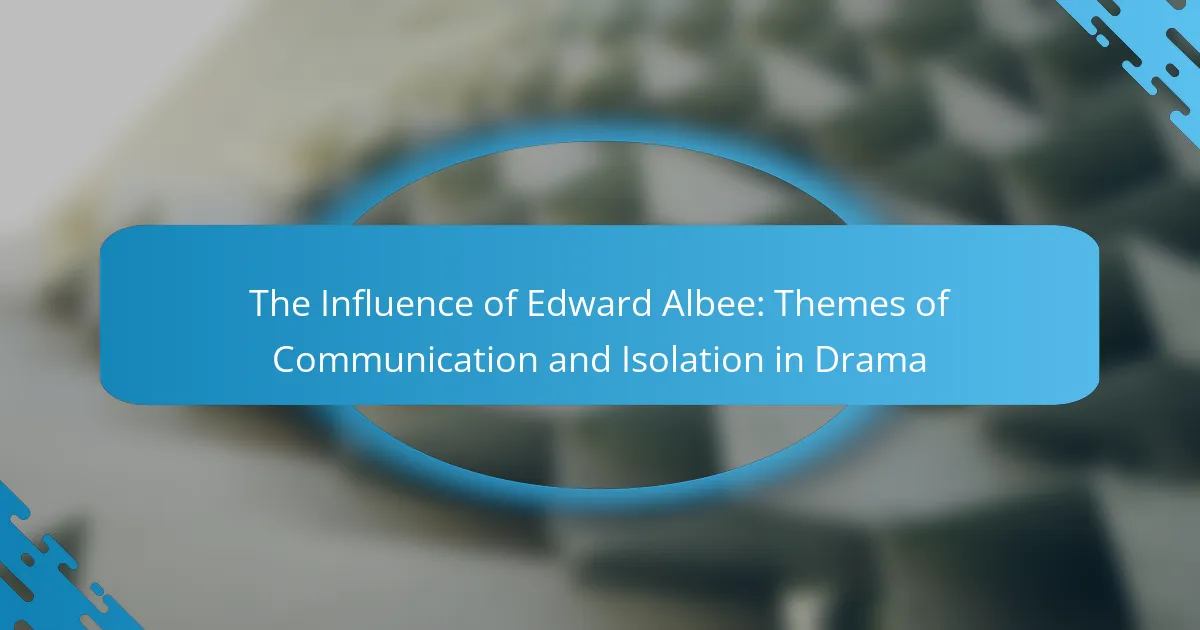Harold Pinter is a pivotal figure in modern theatre, known for his innovative use of language and silence in dramatic structure. His plays feature distinctive elements such as the “Pinter pause,” which creates tension and invites reflection, while his dialogue often conveys subtext, revealing deeper character relationships and intentions. Pinter’s unconventional narrative style emphasizes moments of interaction over linear storytelling, highlighting themes of power, fear, and identity. His influence is evident in the works of contemporary playwrights who adopt similar techniques, underscoring his lasting impact on the evolution of theatre.

What is the Influence of Harold Pinter in Dramatic Structure?
Harold Pinter significantly influenced dramatic structure through his unique use of language and silence. His plays often feature pauses and silences that create tension and ambiguity. Pinter’s dialogue is characterized by subtext, where characters say one thing but mean another. This technique shapes the audience’s understanding of the characters’ relationships and intentions.
Pinter’s use of the “Pinter pause” emphasizes emotional weight and allows for reflection. His structures often defy traditional narrative arcs, focusing instead on moments of interaction rather than linear progression. This approach invites audiences to engage with the underlying themes of power, fear, and identity.
Pinter’s impact is evident in the works of contemporary playwrights who adopt similar techniques. His innovative style has reshaped modern theatre, making silence as significant as spoken words.
How does Pinter’s use of language shape his plays?
Pinter’s use of language shapes his plays through the strategic employment of pauses and subtext. His dialogue often features interruptions and silences that create tension. These pauses compel audiences to engage actively with the characters’ emotions. The sparse language reflects the underlying themes of alienation and communication breakdown. Pinter’s characters frequently speak in incomplete thoughts, which emphasizes their psychological complexity. This technique mirrors real-life conversations, where meaning is often implied rather than stated. For instance, in “The Birthday Party,” the ambiguity of language contributes to the sense of menace. Overall, Pinter’s distinctive linguistic style is essential for conveying the emotional landscape of his works.
What role does dialogue play in Pinter’s dramatic works?
Dialogue in Pinter’s dramatic works serves as a tool for communication and miscommunication. It often reveals character intentions and underlying tensions. Pinter’s dialogue is marked by pauses and silences, emphasizing the subtext. These elements create a sense of ambiguity and uncertainty. Characters frequently engage in repetitive exchanges, highlighting their emotional isolation. The rhythm of dialogue contributes to the overall atmosphere of tension. Pinter’s use of language reflects the complexities of human relationships. This approach challenges conventional narrative structures and engages the audience on a deeper level.
How do silences contribute to the tension in Pinter’s plays?
Silences in Pinter’s plays create significant tension by emphasizing unspoken conflict. These pauses often reveal characters’ inner turmoil and discomfort. The absence of dialogue forces the audience to engage with the underlying emotions. Pinter’s use of silence highlights the power dynamics between characters. For instance, a character’s hesitation can signify fear or uncertainty. This tension builds as the audience anticipates what will be said next. The strategic placement of silence enhances the dramatic impact of the spoken words. Overall, silences serve as a powerful tool to amplify emotional stakes in Pinter’s work.
Why is silence significant in Pinter’s writing?
Silence is significant in Pinter’s writing because it conveys tension and meaning beyond words. Pinter uses silence to create a sense of discomfort among characters. This technique emphasizes the unspoken emotions and underlying conflicts. Silence often serves as a powerful tool to illustrate the fragility of communication. In many of his plays, pauses punctuate dialogue, heightening the impact of what is said. Critics note that Pinter’s use of silence reflects existential themes and the ambiguity of human relationships. The pauses allow audiences to interpret characters’ thoughts and feelings, adding depth to the narrative. Overall, silence in Pinter’s work enhances the dramatic structure and enriches the audience’s experience.
What are the different types of silence used by Pinter?
Harold Pinter uses different types of silence in his plays, which serve various dramatic purposes. One type is “existential silence,” reflecting characters’ inner turmoil and isolation. This silence emphasizes the characters’ struggles with identity and meaning. Another type is “dramatic silence,” which heightens tension and anticipation in key moments. This form of silence creates a pause that draws the audience’s focus to the unfolding action. Additionally, “communicative silence” occurs when characters are unable to express their thoughts verbally. This silence reveals the limitations of language and the complexity of human relationships. Pinter’s use of silence is integral to his unique style and thematic exploration in drama.
How does silence enhance character development in his plays?
Silence enhances character development in Harold Pinter’s plays by creating tension and revealing inner conflicts. Pinter uses silence to convey unspoken thoughts and emotions. Characters often communicate through pauses, allowing the audience to interpret their feelings. This technique deepens the psychological complexity of the characters. For example, in “The Homecoming,” silence underscores the power dynamics between family members. It highlights their emotional distance and unresolved issues. Pinter’s strategic use of silence invites viewers to engage with the subtext. This approach transforms dialogue into a multifaceted exploration of character relationships.
What themes are prevalent in Pinter’s works?
Harold Pinter’s works frequently explore themes of power, identity, and existential uncertainty. Power dynamics manifest in the relationships between characters, often highlighting manipulation and control. Identity is portrayed as fluid, with characters frequently grappling with their sense of self. Existential uncertainty permeates Pinter’s narratives, reflecting the unpredictability of human existence. These themes are evident in plays like “The Birthday Party” and “The Homecoming.” In “The Birthday Party,” the characters’ identities are questioned through their interactions with intruders. “The Homecoming” showcases power struggles within a family, illustrating complex relational dynamics. Pinter’s distinctive use of language and silence further emphasizes these themes, creating tension and ambiguity.
How does Pinter explore power dynamics through language?
Pinter explores power dynamics through language by utilizing pauses, interruptions, and subtext. His characters often engage in fragmented dialogue that reflects their struggle for control. The use of silence becomes a powerful tool, conveying tension and unspoken authority. Pinter’s characters frequently manipulate language to assert dominance or conceal vulnerability. For example, in “The Homecoming,” the power shifts through verbal sparring and the strategic use of silence. This technique highlights the underlying threats and insecurities present in interpersonal relationships. Overall, Pinter’s language intricately reveals the complexities of power and communication in human interactions.
What impact does existentialism have on Pinter’s narrative style?
Existentialism significantly influences Pinter’s narrative style. It manifests through themes of absurdity and the human condition. Pinter’s characters often face existential dilemmas. They grapple with meaninglessness and isolation. Dialogue in his plays reflects this struggle. Characters frequently engage in fragmented, disjointed conversations. This mirrors the confusion inherent in existential thought. The use of silence also emphasizes existential themes. Silence becomes a powerful tool for conveying tension and uncertainty. Pinter’s narrative structure often eschews traditional plot development. Instead, it focuses on character interactions and their existential crises. This approach invites audiences to confront the absurdity of existence.
How does Pinter’s dramatic structure differ from traditional forms?
Pinter’s dramatic structure differs from traditional forms by emphasizing pauses and silences. His plays often feature incomplete dialogue and unspoken tensions. This creates a sense of ambiguity and uncertainty. Traditional drama typically relies on clear exposition and resolution. Pinter’s use of the “pause” invites audience interpretation. It allows for deeper emotional engagement with characters. His works challenge conventional narrative arcs. This results in a unique theatrical experience that reflects real-life communication.
What unique attributes define Pinter’s approach to plot development?
Pinter’s approach to plot development is characterized by ambiguity and non-linear storytelling. His works often feature minimal exposition and rely heavily on subtext. This creates tension and uncertainty within the narrative. Pinter frequently employs pauses and silences, enhancing the emotional weight of dialogue. His characters often experience power struggles, revealing their complex relationships. The use of everyday language contrasts with the underlying themes of menace and existential dread. Pinter’s plots often defy traditional structures, focusing instead on moments of revelation and confrontation. This distinctive style has influenced contemporary drama significantly.
How does Pinter’s style influence contemporary playwrights?
Pinter’s style significantly influences contemporary playwrights through his use of language and silence. His dialogue often features pauses and subtext, creating tension and ambiguity. This technique encourages writers to explore deeper emotional landscapes in their characters. Pinter’s focus on the absurdity of human communication inspires playwrights to challenge traditional narrative structures. His themes of power dynamics and existential uncertainty resonate in modern works. Many contemporary plays reflect Pinter’s influence by incorporating non-verbal communication to convey meaning. The impact of his style is evident in the works of playwrights like Caryl Churchill and David Mamet. Their plays often echo Pinter’s exploration of language’s limitations and the complexity of human relationships.
What are the key elements of Pinter’s dramatic techniques?
Harold Pinter’s dramatic techniques are characterized by the use of pauses, subtext, and ambiguity. Pauses create tension and allow for emotional depth. Subtext conveys underlying meanings that are not explicitly stated. Ambiguity invites multiple interpretations of characters’ actions and dialogues. Pinter’s use of language often reflects the power dynamics between characters. The interplay of silence and speech enhances the dramatic effect. His plays frequently explore themes of isolation and existential uncertainty. These elements contribute to the unique style that defines Pinter’s work in modern drama.
How does Pinter utilize pauses and interruptions in dialogue?
Pinter utilizes pauses and interruptions in dialogue to create tension and convey subtext. These elements serve to highlight the emotional states of characters. Pauses can indicate hesitation or uncertainty, allowing the audience to infer deeper meanings. Interruptions often disrupt the flow of conversation, reflecting power dynamics and conflict. For example, characters may cut each other off to assert dominance or avoid uncomfortable topics. This technique enhances the realism of interactions. It also engages the audience by prompting them to fill in the gaps. Overall, Pinter’s use of pauses and interruptions is a hallmark of his dramatic style.
What is the significance of subtext in Pinter’s plays?
Subtext in Pinter’s plays is significant as it reveals the underlying emotions and tensions between characters. Pinter often uses pauses and silences to create layers of meaning. This technique allows audiences to interpret what is not explicitly stated. The interplay of dialogue and silence reflects the complexity of human relationships. For example, in “The Homecoming,” the subtext exposes power dynamics and unresolved conflicts. Critics highlight that Pinter’s use of subtext challenges traditional narrative forms. It encourages viewers to engage actively with the text. Thus, subtext is crucial for understanding character motivations and thematic depth in Pinter’s work.
How can one analyze Pinter’s influence in modern theater?
Harold Pinter’s influence in modern theater can be analyzed through his unique use of language and silence. Pinter’s plays often feature pauses and subtext, creating tension and ambiguity. This technique has reshaped dialogue in contemporary drama. His exploration of power dynamics and existential themes is evident in works like “The Homecoming” and “The Birthday Party.” These elements have inspired numerous playwrights to adopt similar styles. Pinter’s impact is also seen in the rise of absurdist theater, where communication breakdowns are central. His focus on the unsaid has encouraged deeper character studies in modern plays. Overall, Pinter’s innovations continue to resonate in today’s theatrical landscape.
What methodologies are effective for studying Pinter’s works?
Effective methodologies for studying Pinter’s works include textual analysis, performance studies, and historical context examination. Textual analysis focuses on the language, structure, and themes within Pinter’s plays. This approach allows for a detailed understanding of his use of silence and subtext. Performance studies explore how Pinter’s plays are interpreted in various productions. This method highlights the dynamic nature of his works and their impact on audiences. Historical context examination situates Pinter’s plays within the socio-political landscape of his time. This approach provides insights into the influences that shaped his writing. Each methodology contributes to a comprehensive understanding of Pinter’s contributions to drama.
How can understanding Pinter’s language and silence benefit actors and directors?
Understanding Pinter’s language and silence enhances actors’ and directors’ performances. Pinter’s dialogue often contains subtext, requiring actors to convey meaning beyond spoken words. This depth allows for richer character portrayals. Directors can utilize pauses and silence to build tension and emphasize emotional weight. The strategic use of silence in Pinter’s work creates a unique rhythm, influencing pacing in performances. Recognizing these elements fosters a collaborative environment between actors and directors. This understanding leads to more authentic interpretations of Pinter’s plays. Ultimately, it elevates the overall impact of the production.
What practical insights can be drawn from Pinter’s dramatic techniques?
Pinter’s dramatic techniques emphasize the use of silence and pauses to convey meaning. These techniques highlight the tension between characters and their unspoken thoughts. The strategic use of dialogue often reveals more through what is not said. This approach invites the audience to engage actively with the text. Pinter’s characters frequently experience power struggles, which can be illustrated through their interactions. The minimalist settings often reflect the emotional states of the characters. By focusing on subtext, Pinter encourages deeper analysis of motivations. Such techniques can be applied in contemporary writing to enhance dramatic tension. Understanding Pinter’s methods can aid in creating more nuanced and impactful narratives.
The main entity of the article is Harold Pinter and his influence on dramatic structure through language and silence. The article examines how Pinter’s unique techniques, such as the “Pinter pause,” subtext, and ambiguous dialogue, create tension and engage audiences with themes of power, identity, and existential uncertainty. It highlights the significance of silence in enhancing character development and emotional depth, as well as Pinter’s impact on contemporary playwrights and modern theater. Key elements of his dramatic techniques, methodologies for studying his works, and practical insights for actors and directors are also discussed.



